
* 23 entries including: Africa in 21st century series, India as a military power series, biofuel controversy series, quiet solar cycle, US poison gas disposal difficulties, evolutionary roots of opsin optical proteins, Japan loses confidence in atomic power, parasites manipulate their hosts, outsourced construction techniques, nanowire solar cells, global fall in crime rates, and ESA Gaia sky mapper.

* NEWS COMMENTARY FOR OCTOBER 2013: As reported by an article from TIME magazine ("Reshaping The Army" by Mark Thompson, 4 November 2013), the US military is facing sharp budget cuts while it winds down from the wars in Iraq and in Afghanistan. All the US armed services are faced with painful choices, but the Army seems to have the biggest challenge.
The US Army has well over half a million officers and troops in the ranks, and may lose a tenth of them by 2015; in ten years, it may be three-quarters as big as it is now. In 2012, the Army's budget, going on $200 billion USD, was more than the budget of any other country's entire military force, with only China coming at all close. That much money's not going to be there for the foreseeable future. The question about cuts is whether they're a bad thing or not, the answer being dependent on the political and strategic question of what the Army's mission is.
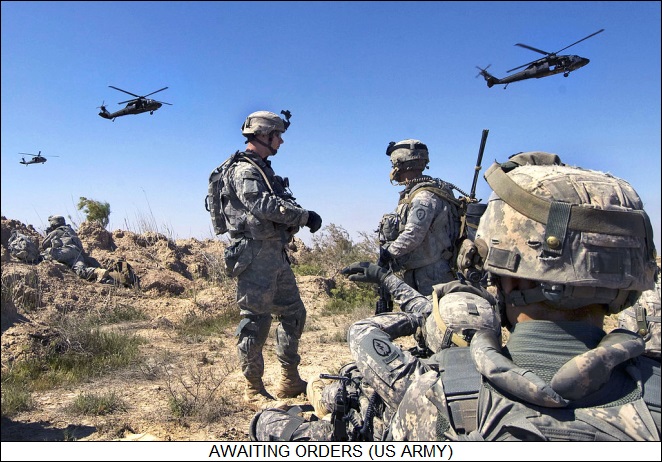
The modern US Army came of age in World War II and honed its mission in the Cold War, the vision being a battle against a "peer adversary" -- that is, the USSR. A fight with a peer adversary still remains the mindset in the Army, but is it realistic? The Army has ranks of heavy weapons to fight the big war, most being updated versions of those acquired in the Reagan buildup of the 1980s: M1 tanks, the multiple-launch rocket system, the AH-64 Apache gunship, and so on.
Yes, the Army has adopted drone aircraft and, to a degree, lightweight smart weaponry for the troops, but they're not the big-ticket items, and the Army's procurement seems to still be focused on acquiring heavy metal. Similarly, although American special operations forces are getting a workout these days, the US Army Special Operations Command (SOCOM) only gets less than a percent of the Army's entire budget.
For over a decade there's been talk of moving towards a lighter, more mobile Army -- smaller in numbers and with a smaller ratio of officers to enlisteds, with less heavy gear and more smart weapons. Yes, there's the risk of ending up with a force that's too light to take on a major adversary, but until the exact threats the Army is supposed to deal with are defined, there's no way of reasonably defining what "too light" amounts to. Few in the political leadership, the people who ultimately call the shots, seem to want to come up with that definition, with Defense Secretary Chuck Hagel -- a decorated Army Vietnam combat veteran -- talking about shrinking the Army incrementally, but not making any changes in its basic organization.
Traditionally, America went to war and then, the war over, let the military go dry -- but since World War II, the USA has maintained large standing forces. There's no real urge to let the military wither again, World War II having done much to discredit isolationism and lack of preparedness. However, if the US Army persists in a form that can't be effectively maintained on the available budget and isn't organized to deal with actual threats, we aren't doing preparedness any favor.
* As reported by an editorial in BLOOMBERG BUSINESSWEEK, class-action suits -- alliances of large numbers of plaintiffs pressing a common complaint -- have been in steady decline, and upcoming US Supreme Court decisions seem likely to accelerate their disappearance.
Mass litigation began in the activist environment of the late 1960s, not merely because of a public urge to bring the "Establishment" to heel, but also because of a loosening of court rules. Corporations were then targeted for harm they had done to large segments of the public, the practice reaching a peak with the class-action suits of the 1990s, in which tobacco companies were sued for ailments suffered by smokers, with state governments backing up the suits.
Class-action suits could be seen as a measure of public empowerment and a restraint on irresponsible conduct of corporations; but the tobacco suits illustrated the ambiguity of the measure. Everyone knew that smoking wasn't healthy, so there was a voluntary element in smoking that had to be balanced against organizational liability; and if tobacco was indeed so dangerous, why wasn't it outlawed? The tobacco suits seemed like a way of bypassing responsible regulatory process, promising nothing but a legal free-for-all that would profit no one but lawyers.
That might be argued; less arguable was the way gangs of unscrupulous lawyers worked the system, sending out mailings to bring in plaintiffs with promises of rewards, slapping a huge suit on a big corporation, then agreeing to a settlement that left plaintiffs with nothing while the lawyers went home with huge legal fees. Dealing with a big lawsuit was expensive for a company; even if the lawsuit was completely bogus and certain to fail in court, the company had an incentive to settle out of court quickly, as long as the settlement cost was clearly less than that of continuing the lawsuit. Paying off a handful of lawyers seemed cheap at the price, since the lawyers really didn't care about payments for the plaintiffs.
It's an iron law: if there's a system, somebody's going to game it. In 2007, a group of California pressed a huge suit on Ford Motor Company over allegedly defective Explorer SUVs, pocketing $25 million USD in fees, while plaintiffs got a $500 USD coupon towards the purchase of a new Ford. Few of the coupons were redeemed. While class-action suits have their defenders, they are in an awkward position to justify such "coupon cases", all the more so because a number of prominent lawyers playing such games have been disbarred or convicted.
Supreme Court Justice Antonin Scalia has been leading the charge against class-action suits; Scalia is notoriously conservative, but in this case the court tilts towards his views. In 2011, a five-justice majority ruled against a class-action discrimination suit by 1.5 million female employees of Walmart, Scalia writing that the women:
BEGIN QUOTE:
... wish to sue about literally millions of employment decisions at once. Without some glue holding the alleged reasons for all these decisions together, it will be impossible to say that examination of all the class members' claims for relief will produce a common answer to the crucial question of: "Why was I disfavored?"
END QUOTE
In short, Scalia was emphasizing the long-standing legal principle that the burden of proof is on the accuser. Claims of discrimination not established in any provable policy of Walmart management, instead supposedly demonstrated by a perceived pattern of actions, did not and could not meet a burden of specific proof in any individual case buried in the pile of cases covered by the lawsuit. The Walmart precedent has led to more dismissals of class-action suits by lower courts and reduced numbers of filings.
The Supreme Court hasn't stopped there, ruling in March to block a monopolization suit against Comcast. Two more big cases are coming up, and a third is being considered. This third case is particularly ironic, since it stems from a resolved coupon case against Facebook for privacy violations, in which the lawyers got over two million dollars and the users got effectively nothing. The users protested to the high court; observers doubt that if the court hears the case, the users are going to be happy with the result. The fading of the class-action suit has an obvious downside for consumers, depriving them of a tool to protect their interests -- but unfortunately, it's proven a tool so easily abused that it's hard to feel much but satisfaction in its disappearance, or accept that it actually had any net value making it worth retaining. If there are fundamental problems that need to be fixed, the courts aren't necessarily the appropriate avenue for doing it.
* The US has taken a lot of flak internationally for its use of armed drones to kill terrorists, most of these missions being flown over Pakistani territory. Pakistanis are not at all happy with these intruders, and the Pakistani government complains -- at least publicly, the protests possibly being little more than window dressing, and understood to be such by the US government.
As reported by a note from THE ECONOMIST, a year ago Sofia Khan, a school administrator from Islamabad, went into the wild Federally Administered Tribal Areas (FATA) where the strikes most often take place, to get surprising feedback. One local man heatedly defended the drone strikes and would like to see more of them. The logic is simple: the terrorists inflict their terror on locals, while the American strikes are generally well-focused, much more so than the indiscriminate artillery barrages favored by Pakistan's army in their incursions into the FATA. Other visitors to the FATA have heard similar things from locals. The difficulty is that it is very hard to get believable statistics from the FATA, not just because of the primitiveness of the region, but because people fear to be too outspoken lest they get a visit from angry gunmen. Indeed, there may be more support for the strikes in Pakistan as a whole -- but given the widespread lawlessness there, few are inclined to speak up in their defense.
COMMENT ON ARTICLE* SILENT SUN: As reported by an article from THE NEW YORK TIMES ("The Sun That Did Not Roar" by Kenneth Chang, 23 September 2013), our Sun undergoes an 11-year cycle of activity, reaching a peak of noisy activity, marked by outbursts of sunspots and flares, to go quiet again. This summer was supposed to be a peak -- but the Sun has been placid, with the occasional sunspot or relatively small outburst. According to Joseph Kunches, a space scientist at the Space Weather Prediction Center of the US National Oceanic & Atmospheric Administration: "The truth of it is there isn't a lot going on. It's been a bit of a dud. You look at the Sun today and you say: What?"
This is good news for satellite companies and power grid operators, who fear a "solar tsunami" -- as discussed here in 2010. They had been dreading the arrival of the solar maximum, and have been pleased to find they had nothing to dread, at least for now. However, it's been a humbling experience for scientists probing the interior of the Sun.

They do know that, inside the Sun, flows of electrons and protons generate magnetic fields that rise and fall on that roughly 11-year cycle. At solar maximum, the magnetic fields at the poles basically disappear for a brief time, and when they re-emerge, the Sun's magnetic polarity has been reversed. The turbulent magnetic fields create regions that are cooler and darker, the sunspots; the magnetic fields within sunspots periodically snap, releasing enormous bursts of energy in solar flares and coronal mass ejections. However, some solar cycles are violent, others calm, and nobody's really certain why there's an 11-year cycle.
This cycle is the 24th since scientists began counting. Early on, some predicted an active cycle, while others predicted a quiet one. Whether just a lucky guess or not, the advocates of the silent Sun began to seem vindicated when the lull of the solar minimum stretched out for longer than normal. In 2008, the Sun was spotless on 266 days, the blankest in half a century; in 2009, when sunspots should have picked up, the Sun was blank for 260 days.
Things seemed to be going back to normal in 2010 and particular 2011, with activity increasing, but then sunspots started falling again. That was not seen as extremely puzzling, since there have been cycles in which the Sun's northern hemisphere became active first, meaning as activity in the northern hemisphere fell off, it might be expected that activity in the southern hemisphere would pick up. Activity did pick up in the southern hemisphere, but then leveled off and stayed level through 2012. If it doesn't pick up in 2014, it's going to be one of the most unusual solar cycles ever, late to start, early to end -- about two years early.
The last time the solar cycle was this quiet was with Cycle 14, which reached its peak, such as it was, in 1907. This time around, we've got space observatories to keep a closer look at the Sun, providing clues on its behavior. The quiet Cycle 24 suggests that the flow patterns within the Sun are more complicated than thought, and need more examination.
There is clearly a cycle in progress, just a subdued one. The Sun's magnetic field in the process of flipping: the north pole has flipped, while the south pole is lagging behind. The unusually quiet solar cycle may provide hints into how the Sun operates, possibly even helping researchers to figure out when an unusually violent solar cycle will arrive, giving us time to prepare.
[ED: Just to demonstrate the unpredictability of nature, on the last weekend of October the Sun decided to not be so quiet and produced three flares of the most powerful known class, along with 15 smaller flares. Of course, nobody knows if the Sun is going to settle down again. It seems to be just trying to confound the theorists.]
COMMENT ON ARTICLE* POISON GAS NIGHTMARE: The claims that Syria's ruling regime under President Bashar al-Assad had used poison gases against rebel forces led to an international outcry, and pressure that forced Assad to agree to the destruction of his stockpile of chemical weapons -- estimated at a total of about 900 tonnes (1,000 tons). As discussed in an article from BLOOMBERG BUSINESSWEEK, the experience of the USA in disposing of such poisons shows it may not be easy.
America began to dispose of its chemical weapons arsenal in the 1980s. The USA signed the Chemical Weapons Convention in 1993, the goal being to destroy all American lethal chemical weapons by 2012. While about 27,000 tonnes (30,000 tons) had been destroyed by that date, the task is nowhere near complete. A base near Pueblo, Colorado, still has about 2,350 tonnes (2,600 tons) of mustard agent to dispose of, while a site near Blue Grass, Kentucky, has 475 tonnes (423 tons) of nerve agents.
The Blue Grass site stores its chemical weapons in 45 semi-buried bunkers. The first shipment of the weapons arrived in a locked boxcar in 1961, kept under heavy guard, its contents secret to everyone but the brass. Once the weapons had been stowed, the staff there monitored them with help of rabbits. When an inspection came up, workers would put three bunny hutches in a bunker -- front, center, back -- and leave them there overnight. A worker recalled: "Once in a while, you'd get a dead rabbit."
The community of Blue Grass only found out about the poison gases in 1984, when the military announced the stockpiles would be incinerated. That was done at several sites, most notably Dugway in Utah, which stored 45% of the US chemical weapons stockpile. Blue Grass citizens were not reassured, however, worrying that the burning would produce dangerous contaminants; they fought back until 1996, when Congress ordered the military to think of some other way of disposing of the poisons.
A "neutralization" scheme was chosen. Workers will place warheads on a conveyor belt that will take them into a sealed room with thick concrete walls, ceiling, and floor. Inside the room, the robots will defuze the weapons and drain the chemicals into a vat containing hot water and a caustic solution. The sludge that results will be treated with heat and pressure to break it down into carbon dioxide, water, and salts. A similar facility is being built at the Pueblo site.
It's not going to be cheap. A project manager for Bechtel, which is building the facilities, commented that typically such a facility takes "an average of four to five years to build and then two to three years to ... test. Then, depending on the stockpile, it can range from three to six years for destruction. They're long projects." That's even working 24:7:365.
The pricetag for the cleanup is estimated at $35 billion USD. The Pueblo facility is scheduled for opening in 2015, while the Blue Grass facility is slated to come up in 2020. The last weapons are to be disposed of in 2023, if all goes to plan. Considering the previous delays in the disposal exercise, that might be judged optimistic.
COMMENT ON ARTICLE* INDIA AS A MILITARY POWER (3): As a footnote to this series, an essay in THE ECONOMIST ("So Near, And Yet ...", 29 June 2013) discussed Indo-American relations. They were long nettlesome, America during the Cold War having a distaste for India's "non-aligned" status, with India having a mirror-image distaste for the overbearing American superpower.
The end of the Cold War suggested an eventual thaw in relations, though the ice didn't really break until 2005, when US President George W. Bush, inclined to a fault to place weight on personal friendship, worked a deal with Indian Prime Minister Manmohan Singh to recognize India as a nuclear power, leading in 2008 to a cooperative arrangement pushed by Singh for civil nuclear cooperation. Underlying the rapprochement was the emerging power of China: both India and the USA wanted to restrain Chinese power, and the USA clearly recognized India as more of a democratic kindred spirit than authoritarian China.
There have been yearly dialogue sessions between the US and India since relations leveled out -- the most recent being in June, between American Secretary of State John Kerry and his Indian counterpart, Salman Kurshid. In their talks, both sides continue to emphasize the fundamentals that draw the two nations together; however, in practice, the discussions tend to focus on squabbles that drive them apart.

There are three causes for difficulty. The first is the impending withdrawal of the US and NATO from Afghanistan. That, in itself, was inevitable; the problem from India's point of view is that Pakistan will then become the dominant external player in Afghanistan. That wasn't such a problem to India a year ago, when America's relations with Pakistan, the USA's most exasperating ally, were at a low point. However, there's nothing new about friction between the US and Pakistan, the painful relationship somehow endures, and things have gone back more or less to their normal rocky state. The US has been sending diplomats to Delhi to make sure India's concerns in Afghanistan are addressed, at least as well as they can be.
The second cause for difficulty is Barack Obama's overtures to China, most prominently demonstrated by his head-to-head meeting with the new Chinese leader, Xi Jinping, in June. India and the USA may be closer ideologically; but, as mentioned in the previous installment, China is a much more important trading partner to the US than India. In addition, America does not want China as an enemy, preferring to work out differences of opinion through diplomatic channels. Indian leadership worries, as noted in the previous installment, that though the USA is unlikely to be an outright ally of China, America will not be an ally of India in a confrontation with China.
Third, there are conflicts between India and the USA over two of India's biggest businesses, information technology and pharmaceuticals. Indian leaders are not happy about the restriction of American visas to Indian engineers, blocking them from working in Silicon Valley, and are defensive against complaints by US pharmaceutical giants over alleged intellectual property infringements by Indian firms. American firms are, for their part, not happy about being tied up in Indian red tape in trying to do business in the country. Given the intractability of the business disputes, Kerry has been accentuating the positive in other domains, for example in cooperation on environmental goals -- while emphasizing that India obviously needs to place development and prosperity as a more important goal.
Indeed, despite all the squabbling, there's plenty to be said for the upbeat view, India and the USA now having extensive military, commercial, cultural, educational, and scientific connections that continue to be enhanced. What more do both sides want? American leadership is certainly not interested in an Indo-American alliance against China, and Indian leadership may not be either, since such an arrangement might well lead to a disastrous and unwanted war. What America really wants is a strong, prosperous India that is a counterweight, but not an enemy to, China. The fact that a strong India may well be less agreeable to American initiatives than a weak one is clearly understood, and accepted, in Washington DC. [END OF SERIES]
START | PREV | COMMENT ON ARTICLE* AFRICA IN THE 21ST CENTURY (12): As reported by an article from THE ECONOMIST ("A Continent Goes Shopping", 18 August 2012), African economic development is leading to the emergence of a consumer class. Frank Braeken, boss of the African component of the Anglo-Dutch consumer products giant Unilever, sees his company as having a big opportunity there. Africans have long been underserved and overcharged; if they wanted to buy shampoos for black hair or cosmetics for black skin, they had to buy expensive American imports. Unilever has moved into the vacuum with the company's line of Motions shampoos and conditioners, to find them a big hit.

Unilever isn't stopping there, either, also introducing other grooming products, as well as foods and detergents. The company is even promoting local business to help drive its own. In 2011, Unilever opened the Motions Academy in Johannesburg, to train up to 5,000 hairdressers every year who will go out and open their own salons. The Motions Academy is also a lab to test products and to try out new business models. If it works out, Unilever wants to try it again elsewhere in Africa.
Unilever is no stranger to the African market. The company made a fifth of its profits in Africa until the 1970s, when it shifted its attentions to Asia. Now Unilever is back, employing 30,000 people on the continent and selling soap, soup and so on to take in about $3.7 billion USD, about 6% or so of the company's global sales. Unilever is already Africa's biggest supplier of consumer goods, and aims to double sales in the next five years by beefing up investment and bringing in more of its brands. Thanks to its energetic commercialism, not merely in Africa but across the developing world, Unilever is booming. Other big consumer-goods companies are trying to get market share in Africa:
The vision of Africa as a sea of poverty is, if not completely wrong, certainly not as true as it once was. Africa has a $1.8 trillion USD economy, with a forecast envisioning a population of 1.3 billion by 2020. "Lion" economies such as Ghana and Rwanda have grown faster than South Korea, Taiwan and other East Asian "tiger" economies in five of the past seven years -- if admittedly from a much lower base.
The African Development Bank, which defines "middle class" as covering anyone who spends the equivalent of $2 USD to $20 USD a day, estimates that more than 34% of Africans, 326 million people, can now be placed in that category. That's up from 27% in 2000. The African Development Bank's definition of "middle class" is financially modest; Africans increasingly have money to spend, but not money to waste, and so manufacturers are necessarily focusing on products that Africans can afford.
According to Sullivan O'Carroll, boss of Nestle South Africa, the challenge is to make products such consumers can afford but still provide value -- foods that are cheap, tasty, and nutritious. For one example of what Nestle refers to as "Popularly Positioned Products", consider "Nespray", an instant milk powder that contains calcium, zinc and iron -- all essential for children -- and sold in a 250 gram pouch that costs only a few rand.
There's also the issue of product distribution. Even in South Africa, which has better roads and a better rail system than most of Africa, it may be hard to get products to customers who are eager and willing to buy them. Nestle delivers directly to spaza shops -- informal convenience stores -- that handle about a third of the national retail market. Many spaza shops are in remote areas and the owners can't afford delivery vans. Nestle takes product to them, having set up 18 distribution centers to do the job, and charges them the same as bigger outlets. Security is another problem; the distribution centers have to be fortified to keep out thieves. Delivery vehicles that collected payments from spaza shops, known as "cash vans", used to be prominently branded, but that was like painting ROB ME in big red letters on them. These days, nondescript white cars are used to do the job.
The margin in pushing product through the spaza shops is small. The shops range from hovels to proper little mini-markets, but they can be hard to find and the owners have little working capital -- about 5,000 rand ($600 USD) is typical. They're not in a position to think big. Nestle sees "microdistribution" to the spaza shops as a marketing expenditure, with hopes only of breaking even, not making a profit. The goal is to widen the customer base, on the expectation that customers will stay with Nestle as they become more prosperous and have more money to spend.
South Africa is a good place to get started with the African consumer, with firms pursuing the "African creep" -- get rolling in South Africa, then move steadily northward. It's not easy to expand; corruption is a widespread problem, and port facilities are weak. In spite of the hassles, businessfolk are upbeat. A couple of decades ago, most African governments made life very hard for business. Now policies are more market-friendly, though there are relapses. Klaus Schwab, founder of the World Economic Forum, says that cynicism about Africa has turned to optimism: "We have a sense that things are really getting better."
ED: In his HITCHHIKER'S GUIDE TO THE GALAXY, Douglas Adams suggested that civilization advances through three levels:
In other words, humanity aspires to middle-class comfort and materialism; once we've all obtained it, we will have arrived. That's not a vision that appeals to the revolutionary-minded, but it could be worse. People who want a cozy home and consumer luxuries generally don't want war or anything else that could violently rock their boat. [TO BE CONTINUED]
START | PREV | NEXT | COMMENT ON ARTICLE* WINGS & WEAPONS: I've been trying to think of a new Thursday column for the blog; more often than not, there are four Thursdays in a month, and it would be nice to have four different columns. I finally settled on a column on aviation and miltech.
* To get the ball rolling, as reported by AVIATION WEEK the Textron company, in collaboration with a startup named AirLand Enterprises, has been promoting its "Scorpion" light multi-role combat aircraft. The Scorpion suggests a jet trainer with pretensions of being an A-10 tankbuster -- sleek, with a tandem cockpit, twin Honeywell TFE731 turbofans with about 17.8 kN (1,815 kgp / 4000 lbf) thrust each, and a wide-span straight wing. It has an internal bay that can accommodate up to 1,360 kilograms (3,000 pounds) of stores or equipment, and up to six underwing pylons capable of hauling up to 2,765 kilograms (6,100 pounds) of stores.
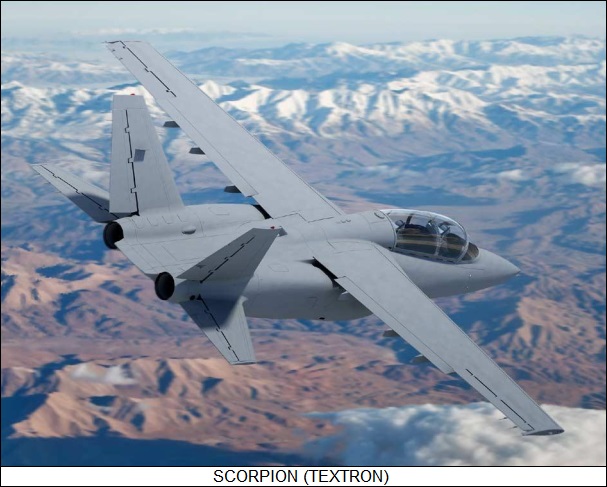
The glass cockpit layout is being provided by Cobham; controls are mechanical, though they could be updated to "fly by wire" for a future drone or "optionally piloted" variant. The Scorpion could be tasked with the attack mission or, with sensor payloads, surveillance and reconnaissance missions, also carrying munitions to hit targets on the spot.
It appears the Scorpion is being targeted at the US Air Force, the selling point of the aircraft being its low acquisition cost and its very low operational cost -- about an order of magnitude less than an F-16 fighter. The Air Force has no requirement for such an aircraft, but in a time of painfully restricted budgets, there are attractions to a cheap jet combat jet. That brings up the image of the Thunderbirds flying the Scorpion: why go to the expense of flying F-16s when a cheaper jet can deliver the thrills to the crowds just as well?
In any case, although there has been considerable industry skepticism about the utility of the Scorpion, Textron sees sales overseas, the aircraft's composite construction being well-suited to tropical environments, and its low cost attractive to governments on a budget. The prototype is slated to fly by the end of the year.
* AVIATION WEEK also reported on the work of Price, a French firm now working on its DGEN 380 and DGEN 390 turbofans, with a thrust of 2.49 kN (255 kgp / 560 lbf) and 3.25 kN (330 kgp / 730 lbf) respectively. Given such modest thrust levels, it's obvious that Price is targeting the light piston aircraft market, selling their DGEN turbofans on low weight, high reliability, smooth operation, fuel efficiency, and lack of fussiness about fuel.
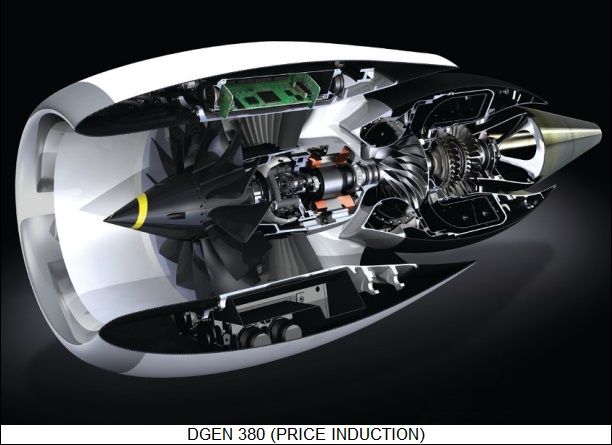
The two engines have essentially the same form factor and share most assemblies; they feature digital engine controls, a geared fan, and a starter-generator built into the engine shaft. Price was founded by one Bernard Etecheparre in the late 1990s and ran its first test engine in 2006; certification is expected soon. In the meantime, Price is selling units to educational establishments, the DGEN series being perfectly representative of contemporary turbofan technology and making excellent training tools.
* Another AVIATION WEEK article discussed the placement of turbofans on pylons on top of the wing of an aircraft, instead of under it or the alongside the tail section, as is typical of business jets and small airliners. The advantage of top-mounting is less weight; the disadvantage is that the airflow drawn in by the engines causes aerodynamic problems for the wings.
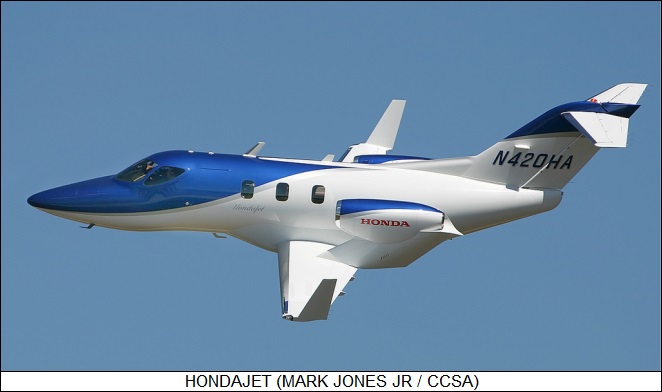
The trick was tried by the unsuccessful German VFW 614 small airliner in the 1960s, though its lack of success wasn't particularly due to engine placement. Honda has revived the idea for the company's Hondajet very light jet, performing studies that showed the best arrangement was on pylons that left the engines almost completely behind the wing, this scheme giving 5% better efficiency than a tail mounting scheme. As turbofans keep getting bigger and more powerful, other firms are considering the overwing arrangement for larger aircraft.
COMMENT ON ARTICLE* ENIGMATIC OPSINS: Our visual system, like all other all visual systems, is based on light-sensitive proteins named "opsins". These molecules seem neatly tailored to the task, but as reported by an article from SCIENCEMAG.org ("Opsins: Not Just For Eyes" by Elizabeth Pennisi, 15 February 2013), that's a misleading impression. Evolution is not a tailor; if it can be personified as anything at all, it's as a wild improviser. Opsins are very ancient, and in the course of their history they've ended up in a lot of organisms that don't happen to have eyes, the opsins serving a range of functions.
The realization of the diversity of opsins began to emerge in the 1990s. In 1998, Ignacio Provencio and Mark Rollag of the Uniformed Services University of the Health Sciences in Bethesda, Maryland, following up the observation that the skin of amphibians reacts to light, announced the discovery of an opsin in frog skin, which they named "melanopsin". It was thought earlier there was one kind of opsin, called "ciliary opsin", in vertebrates, and a more ancient "rhabdomeric opsin" in invertebrates. Confusingly, melanopsin more strongly resembled rhabdomeric opsin than ciliary opsin.
That was the thin entering wedge to a new view of opsins. Provencio and Rollag went on to find melanopsin in the frog eye and brain, with other researchers finding it in a range of animals -- it's found in human and mouse neural tissue, for example. Along with the discovery of melanopsin, a 2003 survey of what was known about opsins in the animal kingdom led to the downfall of the simplistic segregation of ciliary opsin to vertebrates and rhabdomeric opsin to invertebrates.
It was the introduction of low-cost genome sequencing tools that really turned the spotlight on opsins. In 2006 Maria Ina Arnone, a developmental biologist at the Stazione Zoologica Anton Dorhn in Naples, Italy, found genes for opsins in sea urchins, which have neither eyes nor brains. Several years of more work revealed that the base of the "tube feet" that surround sea urchin spines were loaded with photoreceptors, which had been overlooked because they lacked the pigments generally associated with opsins. Sea urchins, it turns out, like the dark, and their photoreceptor system allows them to find it. Although the sea urchin lacks a brain, the photoreceptor cells can provide a "bias" to the sea urchin's nervous system that makes it move towards the dark.
The opsin in the sea urchin photoreceptors is, as would be expected, of the rhabdomeric type, with Arnone finding this particular opsin in the "eyes" at the tips of starfish arms. However, she has also found a ciliary opsin in the tips of the tube feet of sea urchins, in their skin, and in their larvae, the function of this opsin being unclear. What was clear from her studies is that opsins have been around a long time, the enchidoderms -- the group of animals including the sea urchin and starfish -- being of ancient lineage.
That inspired others to start looking for opsins in similarly venerable families, with evolutionary biologist Todd Oakley of the University of California in Santa Barbara looking into the "cnidaria", the stinging jellyfish and hydras, from 2007. His group found opsins in the unique stinging cells of the cnidaria, and also found that bright light inhibited the cells from firing, suggesting a non-optical role for opsins. They went on to find the same situation in the stinging cells of anemones.
Further investigation by other researchers showed that the opsin-laden cells near the stinger cells of hydras also contain taste receptors, suggesting modern photoreceptor cells may have arisen as specializations of more ancient cells that could sense multiple stimuli. The cilia in octopus skin, which is sensitive to mechanical stimulation, contains opsins, suggesting a multimode capability. Opsins have been found in comb jellies -- not related to cnidarian jellies, the comb jellies possibly being of more ancient lineage -- though their opsins have more or less unfamiliar forms, and their functions are unclear.
Even in animals with developed eyes, such as the well-known Drosophila melanogaster fruitfly, opsins seem to support functions other than sight, having been found associated with the fly's antenna ears, and also with temperature sensing. Ultimately, researchers hope to obtain a catalog of opsins across the animal kingdom, with entries describing structure and function, allowing them to trace back the roles these proteins have served in the evolution of perceptions.
COMMENT ON ARTICLE* JAPAN DUMPS THE ATOM: As discussed in an article from THE ECONOMIST ("Power Struggle", 21 September 2013), in mid-September Japan's last operational nuclear reactor, at Oi, was shut down. In principle, it was for routine maintenance; however, no date was given for when it will be restarted -- nor was any given for Japan's other 50 inactivated reactors. Japan has shut down its nuclear power plants as a consequence of the disastrous triple meltdown of the Fukushima Dai-ichi plant, caused by the earthquake and tsunami of March 2011, as discussed here at the time.
The Liberal Democratic Party (LDP), which retook power in December, warns that mothballing the plants is going to be expensive; the industry ministry says that imports of extra oil, gas, and coal to burn in conventional power plants will cost Japan an extra 9.2 trillion yen (about $93 billion USD) by the end of 2013. A badly weakened yen and higher oil prices have made matters worse, with Japan running trade deficits for the first time in three decades.
The alliance of electricity utilities, bureaucrats, academics and heavy industry, known in Japan as the "nuclear village", wants the LDP to restart the reactors; Prime Minister Abe Shinzo would be happy to oblige. Public protests over nuclear power have faded, and Abe's government purged an energy-policy board of anti-nuclear types. However, a new, strengthened nuclear agency, the Nuclear Regulation Authority (NRA), must declare any plant safe before it starts, and several plants sit on or near active faults. In addition, the law gives towns and villages a say over nearby plants, and most Japanese have had it with nuclear power. Continued bad news from the Fukushima cleanup effort has only further soured public support.
Abe cannot override the NRA; the agency has come under pressure, but it is standing firm on reactors located near faults. He can't brush aside political opposition, either. Izumida Hirohiko, governor of Niigata prefecture on the main island's northwest coast, says that around 70% of the prefecture's population are against starting the reactors at Kashiwazaki-Kariwa, the world's biggest nuclear plant. Inside the LDP itself, there are many more critics of nuclear power than there were before March 2011, countering the influence of nuclear backers such as the economy minister, Amari Akira; the critics worry that starting the reactors would backfire on the LDP in the next general elections, due in 2016. The business community also is forecasting that the economy will remain healthy despite the nuclear shutdown.
The result is movement towards other energy supplies. Since 2011 the number of independent power producers exploiting on renewable sources has tripled, thanks to friendly legislation. Including hydro-electricity, renewables now represent 10% of Japan's energy mix, suggesting they may one day replace the share that nuclear power once claimed.
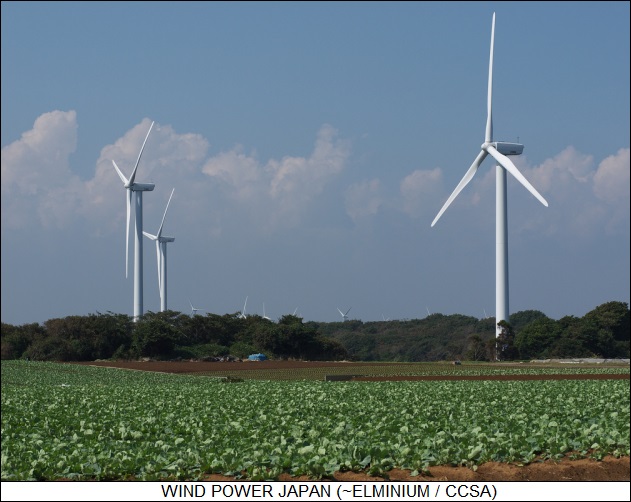
However, renewables face obstacles in Japan. The power utilities control the grids and may not be friendly to independent power producers; and, given Japan's scarcity of land, it's hard to figure out where enough solar panels and wind turbines could be placed to provide any real contribution -- though of course offshoring of wind turbines is a possibility, Japan not having any shortage of coastline. For the immediate future, Japan seems likely to rely on oil, gas, and coal to make up the shortfall. This spring, the US government granted approval for Japan to import American shale gas, which should help reduce the pain of energy imports. Along with a ramp-up in fossil-fuel power generation, Japan has also been energetic in energy conservation. Tokyo alone has cut electricity consumption by a tenth since 2011; LED lighting has become popular.
Political reform may accelerate the shift away from nuclear, with proposals in the works to dissociate generation and transmission, and open the residential electricity market to competition. Japan has long been held hostage to arrangements of convenience between government and industry, at the expense of the consumer; the changes are likely to grant power, quite literally, back to the consumer.
COMMENT ON ARTICLE* INDIA AS A MILITARY POWER (2): Although the Indian Navy has advantages, it is still the poorest of India's three major armed services, receiving only about a fifth of the defense budget, while the Air Force gets a quarter and the Army gets half. The Indian Air Force is at the front of the procurement queue for big-ticket weapon systems, with the IAF now obtaining the advanced French Rafale fighter, as well as upgrading its old fighters with the latest avionics and weapons.
Most of the older aircraft are of Russian origin. Although the IAF has long had British and French combat aircraft in its inventory, the Rafale is a bit of an anomaly, India still having a strong inclination to "buy Russian" -- Hindustan Aeronautics LTD (HAL) is now working with Russia's Sukhoi to develop a "fifth generation" strike fighter to compete with the US F-35. Still, the IAF will buy from anyone who offers the right product at the right price, the service currently expanding its scope through the acquisition of five new airborne early warning and control aircraft -- based on Brazilian Embraer jetliners but with Indian kit -- and also planning to obtain six Airbus A330 tanker-transports. Indeed, with a certain thaw in Indo-US relations, the IAF is even obtaining ten big Boeing C-17 cargolifters, the first US aircraft of consequence to be obtained by the IAF.

The Indian Navy is also now "buying American", obtaining eight Boeing P-8I Poseidon ocean patrol aircraft, based on the Boeing 737 jetliner. The Indian Navy's procurement has little connection to the IAF's efforts; in fact, the three primary services tend to operate with little concern for coordination. The army is preparing for a lightning war against Pakistan, while the Navy is focused on confronting the Chinese Navy; how the IAF fits into either of those strategic considerations is unclear. The IAF doesn't seem to give much priority to battlefield support of the army, and indeed in the fall of 2012 the army was granted the mandate for operation of new Boeing AH-64 helicopter gunships and other attack helicopters -- much to the irritation of IAF brass.
Interservice rivalries are normal in the world's military forces, each armed service competing for resources and influence against the others, but the Indian government's suspicion of the military aggravates the problem. The armed forces do make comforting noises about "jointness", but India lacks a chief of the defense staff of the kind most countries have, the politicians being reluctant to grant any one military man that kind of authority.
The distrust and division also shows up in military procurement. The defense industrial sector, dominated by the overbearing Defence Research and Development Organisation (DRDO), remains stuck in state control and the country's protectionist past. The cost of developing a heavy tank, the Arjun, exceeded the original estimates by 20 times; the army is inclined to stay with its Soviet-made tanks. A program to develop a light combat aircraft, the "Tejas", for the IAF has been dragging on for a quarter century, and the Tejas still hasn't gone into service.
Without a focused reform effort, a good part of the $200 billion USD India plans to spend on weaponry over the next 15 years is likely to be wasted. Corruption in procurement of foreign-made weapon systems is a particular problem, the latest example being a $750 million USD order of VIP helicopters from Italy's Finmeccanica. The firm denies any wrongdoing, but the deal has been put on hold.
Still, Britain, France, Israel, and most significantly Russia are going to make a lot of money from India over the next decade. The US will also benefit -- but despite a groundbreaking civil nuclear deal in 2005 and the subsequent warming of relations, America is still regarded as a less politically reliable partner in Delhi. The distrust stems partly from previous arms embargoes; partly from America's former closeness to Pakistan; and partly from India's concerns about being the junior partner in a relationship with the world's pre-eminent superpower.
It is China that makes India's relationship with the US particularly complicated. Both America and India want to restrain Chinese military ambitions, particularly in the Indian Ocean, but India does not want to provoke China without cause. On the other side of the coin, since China is a much bigger trading partner with the US than India, Indian leadership worries that America might side with China in a crisis. The US is more comfortable with Indian democracy than Chinese semi-authoritarianism, but does democracy count for more than trade?
The overall impression of India's strategic posture at present is one of muddle. Pakistan remains troublesome, but strategic analysts don't believe that issue can be dealt with militarily. Pakistan is in such turmoil that India could make unilateral gestures, such as a drawdown in border forces, to reduce pressure on Pakistan's leadership, which is now bogged down in a vicious struggle with internal terrorism that is pushing the confrontation with India off the front burner.
China's growing military capability and more assertive posture unsettles India; but for the time being, China isn't really an enemy, the country being peaceful and with no sharp axe to grind with India. Still, while Japan and South Korea have the reassurance of formal alliances with the USA, India has no call on the good offices of the American superpower. India is working on regional alliances, but not in any energetic fashion. India shuffles along, held back by caution and bureaucratic inertia; the time is coming when India is going to have to either get serious about its strategic posture, or accept a position of inferiority when it does not need to do so. [TO BE CONTINUED]
START | PREV | NEXT | COMMENT ON ARTICLE* AFRICA IN THE 21ST CENTURY (11): As reported by an article from THE ECONOMIST ("Get A Move On", 16 February 2013), one of Africa's basic problems is transport. It's not so bad in the coastal regions, where shipping can haul people and cargoes with relative convenience; much worse in the interior, due to poor rail and river transport, and notably bad roads. Politics also adds complications, such as obnoxious border crossings and high tariffs. In various locations terrorists, thieves, and crooked police -- the borderlines between the three can be indistinct -- render movement difficult or impossible. Shipping a car from China to Tanzania on the Indian Ocean coast costs $4,000 USD, but getting it from there to nearby Uganda can cost another $5,000 USD.
Transport is a critical element in the continent's struggle to feed itself. According to a recent World Bank report, Africa has an adequate supply of food, it's just not being distributed with efficiently. Subsistence farmers who sell surplus crops typically receive less than 20% of the market price, the rest being soaked up by transport and transaction costs, limiting the incentive for farmers to grow more food. Governments are working on the political issues by implementing free-trade zones; officials from countries in the East African Community and the Common Market for Eastern and Southern Africa have removed some border restrictions and lowered tariffs. Roads are being built, including a link south from Aswan in Egypt that will hook up to another road south to Khartoum in Egypt.
Citadel Capital, a Cairo-based private-equity firm, has an ambitious plan to create a private transport link across the Sahara and into East Africa, connecting the Mediterranean and the Indian Ocean; cargo will be hauled as far as 6,000 kilometers (3,725 miles) over rail and river. That's a much cheaper way to go than hauling by truck, which is over three times as expensive as rail, over five times as expensive as boat.
Parts of the corridor already exist. Citadel Capital is running 42 barges along the length of the Nile in Egypt, and has built or refurbished seven river ports between Alexandria and Aswan, mostly to ship grain, coal, slag and clay. Two years ago, the firm carried the first-ever shipping container on the Nile, long neglected as a transport route; even though 95% of Egyptians live by the river, less than 1% of the goods they need are moved on it. In Sudan, Citadel Capital has struck a deal with the government to use the state-owned rail network, and in South Sudan it operates 12 barges on the Nile to move supplies for oil companies and the World Food Program. Further south in Uganda and Kenya, it has invested in the Rift Valley Railway, a British colonial-era line that runs 2,300 kilometers (1,430 miles) from the coast to the interior.
Such investments have been made possible by privatizations and the opening of markets once dominated by state-owned enterprises. Governments can still be a nuisance; Egypt's barge business loses money since the state subsidizes fuel, giving road haulage an unfair advantage. There are comparable distortions elsewhere in Africa -- but transport is still advancing, with dozens of rail projects in progress at present, including both refurbishment of old lines and development of new ones, to haul people, commodities, and finished goods.
Citadel Capital's grand plan of course also includes new rail lines, though the firm is seeking financial help from the World Bank. The company is struggling to overcome political obstacles -- turmoil in Egypt, the six-month closing of the border between the Sudans -- but Ahmed Heikel, its founder, is confident: "In the long term it will happen." -- waving his hands as if holding a magic wand.
* In related news, in the course of US President Barack Obama's week-long tour of Africa in June, Obama announced the "Power Africa" initiative, which includes an initial $7 billion USD investment by the US government over the next five years. Private companies, including General Electric and Symbion Power, are adding an additional $9 billion USD in their own commitments to develop Africa's electrical power system. More than two-thirds of people living in sub-Saharan Africa do not have electricity, including 85% of those living in rural areas.

The US government and its private sector partners initially will focus its efforts on six countries: Ethiopia, Ghana, Kenya, Liberia, Nigeria and Tanzania. Obama's tour was welcomed by Africans, since the president had largely ignored the continent even though his father was Kenyan and he still has close relatives in Kenya. Ironically, Kenya was dropped off his itinerary because of instability due to the elections there. [TO BE CONTINUED]
START | PREV | NEXT | COMMENT ON ARTICLE* September was a busy month for space launches:
-- 01 SEP 13 / YAOGAN 17 -- A Chinese Long March 4B booster was launched from Taiyuan at 1916 GMT (local time - 8) to put the "Yaogan 17" satellite into orbit. It was believed to be a naval surveillance satellite, possibly with three collaborative payloads in a "flying triangle" configuration.
-- 07 SEP 13 / LADEE -- A US Air Force Minotaur 5 booster was launched from Wallops Island on the Virginia coast at 0327 GMT (local time + 4) to put the NASA "Lunar Atmosphere & Dust Experiment (LADEE) probe into space to investigate the tenuous lunar atmosphere, performing orbital passes as close as 20 kilometers (12 miles) to the Moon's surface. The 383-kilogram (844-pound) probe also carried an experimental laser communications link designed by MIT Lincoln Labs, with a maximum bandwidth of 600 megabits per second.
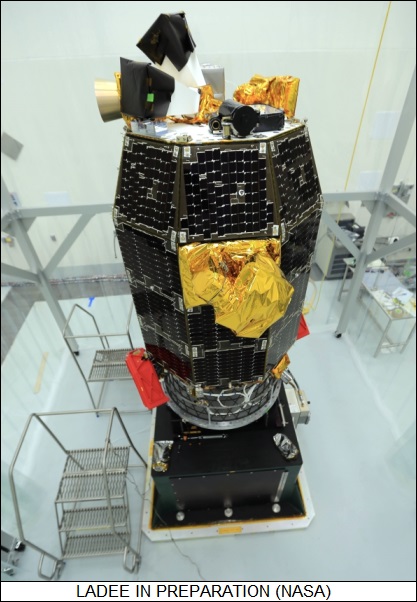
This was the first launch of the Orbital Sciences Minotaur 5, the latest of Orbital's Minotaur boosters, based on surplus US ballistic missile technology. The Minotaur 5 was basically a retired Peacekeeper missile, the first three stages being from the Peacekeeper, along with a Star 48V kick stage, a payload fairing along with spacecraft support structures, and other equipment updates. While the Minotaur boosters are generally reserved for military flights in order not to compete with commercial booster manufacturers, NASA didn't have any other booster of the right size, and dealt with the US Air Force to obtain the Minotaur.
-- 11 SEP 13 / GONETS M x 3 -- A Rockot booster was launched from Plesetsk Northern Cosmodrome in Russia at 2323 GMT (local time - 4) to put three "Gonets M" store-&-forward civil communications satellites into orbit. The full comsat constellation was to be completed, with 12 operational satellites, by the end of 2015.
-- 14 SEP 13 / SPRINT A -- A JAXA Epsilon booster was launched from Tanegashima at 0500 GMT (local time - 9) to put the "SPRINT A" satellite into orbit. SPRINT A stood for "Spectroscopic Planet Observatory for Recognition of Interaction of Atmosphere"; the 350-kilogram (770-pound) satellite was built by NEC Corporation and was intended to observe the interactions of planets with the solar wind. Its primary payload was a 20 centimeter (8 inch) ultraviolet telescope to observe the atmospheres of Venus and Mars. After being established in orbit, SPRINT A was formally named "Hisaki", after a cape near the mission's launch site in Kagoshima prefecture. This was the first flight of the Epsilon booster.
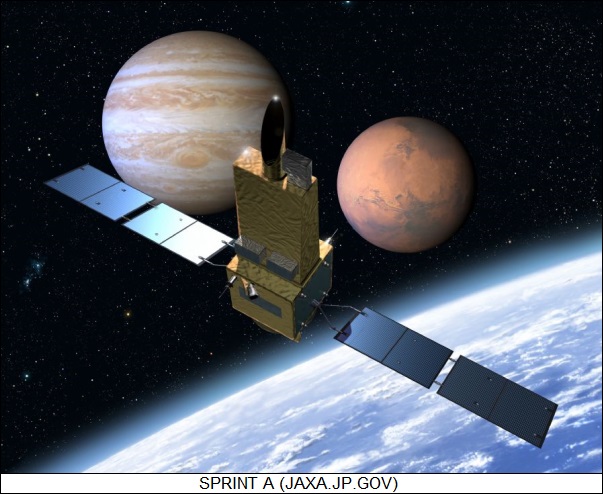
-- 18 SEP 2013] USA CC / ATLAS 5 531 / AEHF 3 -- An Atlas 5 booster was launched from Cape Canaveral at 0810 GMT (local time + 4) to put the third "Advanced Extremely High Frequency (AEHF)" military geostationary comsat into orbit. It featured encrypted / low probability of intercept communications along with jam resistance and resistance to electromagnetic pulse. The spacecraft had a launch mass of 6,150 kilograms (13,565 pounds) and was based on the Lockheed Martin A2100 comsat bus. AEHF is planned to eventually replace the long-standing Milstar military comsat network, with one AEHF having more bandwidth than all five current Milstar spacecraft put together. The Atlas 5 booster was in the "531" configuration, with a 5-meter (16 foot 5 inch) fairing, three solid rocket boosters, and an upper stage with a single Centaur engine.
-- 18 SEP 2013 / CYGNUS 1 -- An Orbital Sciences Antares booster was launched from Wallops Island off the Virginia coast at 1458 GMT (local time + 4) to put the first "Cygnus" supply capsule into space on an International Space Station support mission. The Cygnus capsule docked with the ISS Harmony module eleven days following launch, after performing a series of tests and suffering a few difficulties in docking. The capsule, which had a pressurized cargo module built by Thales Alenia Space in Italy, carried 700 kilograms (1,545 pounds) of cargo.
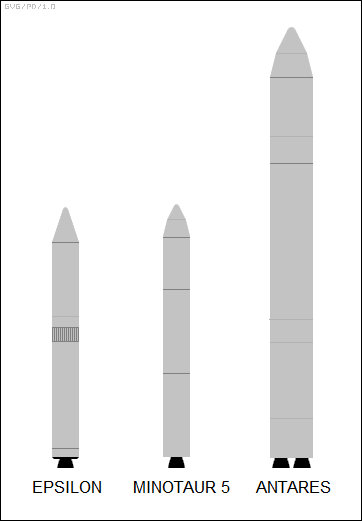
This was the first operational Cygnus launch, the first in a series of nine being performed under contract to NASA. The Antares booster featured a first stage powered by twin Russian-made AJ-26 engines -- powered by kerosene and liquid oxygen, a departure from Orbital's traditional reliance on solid fuel rockets -- and a second stage powered by a Castor 30B solid rocket engine. An optional kick stage was available but not used on this flight. The AJ-26 engines were built in the Soviet era and refurbished; their supply is limited and Orbital is searching for a replacement engine for the long term.
-- 23 SEP 2013 / FENGYUN 3C -- A Long March 4C booster was launched from Taiyuan in China at 0307 GMT (local time - 8) to put the "Fengyun 3C" polar weather satellite into orbit. It had a launch mass of 2,200 kilograms (4,850 pounds). It carried visible and infrared imagers.
-- 15 SEP 2013] RU BK / SOYUZ / SOYUZ ISS 36S (ISS) -- A Soyuz booster was launched from Baikonur at 2058 GMT (local time - 6) to put the "Soyuz ISS 36S" AKA "Soyuz TMA-10M" manned space capsule into orbit on an International Space Station (ISS) support mission. The Soyuz crew included capsule commander Oleg Kotov of the RKA (third space flight), Sergey Ryanzanskiy of the RKA (first space flight), and Michael Hopkins of NASA (first space flight). The Soyuz docked with the ISS upper Poisk module six hours after launch, the capsule crew joining the ISS "Expedition 37" crew of commander Fyodor Yurchikhin, Luca Parmitano of ESA/Italy, and Karen Nyberg of NASA.
-- 29 SEP 13] USA-C VB / FALCON 9 / CASSIOPE -- A SpaceX Falcon 9 booster was launched from Vandenberg Air Force Base in California at 1600 GMT (local time + 7) to put the Canadian Space Agency "Cassiope" satellite into orbit. The hatbox-shaped spacecraft, built by MDA of Canada and with a launch mass of 500 kilograms (1,100 pounds) carried a communications relay payload for a commercial digital broadcast courier service and an instrument to observe the Earth's ionosphere. The rocket was in the "v1.1" configuration with upgraded Merlin 1D engines, stretched fuel tanks, and a payload fairing; this was the first launch of the v1.1 variant.
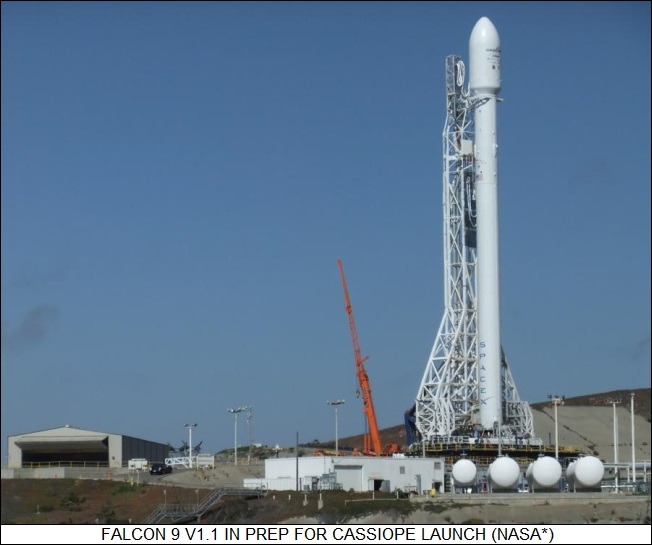
-- 30 SEP 13] RU-C BK / PROTON BREEZE M / ASTRA 2E -- A Proton Breeze M booster was launched from Baikonur at 2138 GMT (local time - 6) to put the SES "ASTRA 2E" geostationary comsat into orbit. The spacecraft was built by EADS Astrium in France and was based on the Eurostar 3000 comsat platform. It had a launch mass of 6,018 kilograms (13,271 pounds), a payload of 60 Ku-band / 4 Ka-band transponders, and a design life of 15 years. It was placed in the geostationary slot at 28.3 degrees East longitude to provide communications services to Europe, Africa, and the Middle East. This was the first Proton launch since a failure on 2 July, in which a payload of three GLONASS navigation satellites was lost.
* OTHER SPACE NEWS: As reported by SPECTRUM.IEEE.org, the ESA is working on an innovative Mars rover, or maybe better put Mars "hopper" that will jump from site to site on rocket power. Well, a rocket of a sort; the ESA study envisions a one-tonne (1.1-ton) lander with a 20-kilogram (44-pound) science payload, a radioisotope thermoelectric generator (RTG), and a thruster system that uses carbon dioxide as a propellant, if not really a fuel.
The RTG actually provides all the power, with the lander sucking in Martian atmospheric CO2, which is then liquefied. After a full load of liquid CO2 has been obtained, a tube loaded with pebbles fabricated from beryllium and boron carbide is heated up, and the liquid CO2 dumped into it. That sends the lander on a short hop to a new site, the range of the hop being about a kilometer. Since the lander doesn't move except in hops, it doesn't need to have the smarts of a rover, and it can go to any site suitable for performing a landing.
* Smallsat maker Surrey Satellite Technology (SSTL) of the UK started out building amateur satellites and then gradually went upscale, most notably producing the satellites for the international Disaster Monitoring Constellation (DMC). Now SSTL is going back downscale a bit, promoting their new "SSTL-X50" satellite platform, which as its name suggests weighs about 50 kilograms (110 pounds) -- about half the weight of a DMC satellite. The X50 is designed for launch in constellations, leveraging off lightweight subsystems to provide constant orbital coverage at low cost.
SSTL literature is promoting three "canned" X50 configurations, including a wide-area mapping satellite, a high resolution imaging satellite, and a multispectral color imaging satellite. User-specified payloads can of course be carried, with the X50 bus providing solar power, three-axis stabilization, thrusters, onboard processing and data storage up into the terabytes, plus a fast data-rate X-band comlink. The new platform is well matched to emerging low-cost smallsat launchers.
* On 3 September, an Israeli Air Force F-15 fighter launched a "Silver Sparrow" target missile from over the Mediterranean. The two-stage Silver Sparrow, no real relation to the well-known Sparrow air-to-air missile, has a length of 8.4 meters (28 feet). This was the first all-up test flight; there was no attempt to destroy it with an Arrow ballistic-missile interceptor. The test clearly reflected regional tensions, but there's an underlying context in the exercise, in that the Silver Sparrow has been judged as a good basis for a smallsat launcher. It is unclear how much interest there is in that application, the current agenda being obviously to make sure it works in its designed role as a target.
COMMENT ON ARTICLE* PUPPET MASTERS: Carl Zimmer is a pop-science writer focused on biology, with a particular interest in parasitology, even writing a book on the subject titled PARASITE REX, outlined here in 2009. Zimmer is always on the lookout for further interesting material on parasites, and reviewed highlights of a paper on the subject in an article for THE NEW YORK TIMES ("Deciphering the Tools of Nature's Zombies", 5 December 2012).
Consider, for starters, the web spider Anelosimus octavius, which resides in the rain forests of Costa Rica. Every now and then one acts strangely, giving up its own tangled web to craft a new, more homelike one for the parasitic wasp larva growing inside of it. When the new web is complete, the spider dies, and the larva emerges into its new home. To manipulate the spider, the wasp larva produces proteins that biochemically alter the spider's behavior.
Researchers have been zeroing in on these proteins and the genes that code them. They have discovered one in the "baculovirus", commonly found on leaves in forests and gardens, where it infects caterpillars. We eat baculoviruses all the time, incidentally, but they pose no hazard to us. They're not harmless to the caterpillars, proliferating rapidly while producing a protein that tells an infected caterpillar to climb upward. The doomed host ends up high in the trees, giving this infection the nickname of "treetop disease". High above the ground, the caterpillar dies and then dissolves, showering viruses on potential hosts below.
David P. Hughes of Penn State University and his colleagues have found that a single gene, named egt, drives the caterpillars up trees. The gene encodes an enzyme that, when generated inside the caterpillar, disables a hormone that signals a caterpillar to stop feeding and molt. The caterpillars become ravenously hungry, climbing higher and higher until they die. Hughes commented: "They're stuck in a loop."
Other parasites manipulate their hosts by altering the neurotransmitters in their brains, that being how thorny-headed worms send their hosts to their doom. Their host is a shrimplike crustacean named a "gammarid" that lives in ponds. They typically respond to disturbances by diving down into the mud, but an infected gammarid races up to the surface of the pond and dashes across the water until it encounters a stem or some other object it can cling to. This is useful to the parasitic thorny-headed worms because, as is fairly common in parasites, they have life cycles that alternate between hosts. Forcing the gammarid to expose itself makes it more likely to be eaten by a bird, which becomes the second-stage host of the worms.
Simone Helluy of Wellesley College found that the worms manipulate the gammarid by using the host's immune system against itself. In response to a worm infection, the gammarid's immune system responds -- but fails to knock out the worms, instead creating an inflammation. The inflammation disrupts the brain's chemistry, in particular causing it to produce plentiful amounts of the neurotransmitter serotonin. Helluy suspects the serotonin confuses the visual reception of the gammarid, causing light to be confused with dark and provoking the host's upside-down behavior.
No parasites are known to produce such well-tuned host behavior in humans, but human parasites do seem to have effects. Considerable research has been done on the protozoan parasite Toxoplasma gondii -- discussed several times here, last in 2012 -- which normally infects rats and cats. Rats infected with T. gondii lose caution and all but invite being attacked by a cat. It was discovered that the parasite accelerates production of the neurotransmitter dopamine, apparently making the rats more curious and less cautious; further research shows the parasite also accelerates production of testosterone in male rats, making them more inclined to breed, and so spread parasites, as well as bolder and more willing to take risks.
Humans can acquire T. gondii by handing contaminated cat litter -- the parasite is passed in cat feces -- or by eating contaminated meat. It is suspected that the parasite might be a contributing factor to schizophrenia, with considerable investigation now being performed on what happens to infected humans. Shelley Adamo of Dalhousie University in Nova Scotia sees "neuroparasitology" as a new frontier for research, saying: "The last 5 to 10 years have really been exciting."
Adamo believes that parasite host alterations might give insights into developing drugs to treat personality disorders. The traditional approach has been to develop a single drug with a known effect, such as Prozac, but parasites tend to use a set of tools to modify host behavior, Adamo commenting: "Perhaps tweaking several systems simultaneously might give better results than trying to hit one particular system with a sledgehammer."
Parasites have been at the behavior modification game for a long, long time and may have tricks to teach us. As Adamo admits, right now we don't know much about those tricks, and it's going to take some effort to figure them out.
COMMENT ON ARTICLE* OUTSOURCED CONSTRUCTION: While many products used by Americans are imported from overseas, traditionally construction projects were local affairs. To be sure, they might be handled by foreign firms and use imported materials, but they were built on the spot. How else could they be built?
As reported by an article from BLOOMBERG BUSINESSWEEK ("Need A New Building?" Call The Philippines" by Bruce Einhorn & Mathew Philips, 9 September 2013), construction projects can now be offshored, as demonstrated by the Atlantic, Gulf, & Pacific Company of Manila, in the Philippines. AG&P has a long history, having been founded in 1900 by two Americans during the US occupation of the Philippines, to then build much of Manila's water and sewage system. In recent decades AG&P fell into decline, to be taken over in 2010 by Joseph Sigelman -- originally a Lazard & Goldman Sachs banker, who in the 1990s set up OfficeTiger in India to provide outsourcing for business support functions. He took over AG&P in 2010 and proceeded to internationalize it.
AG&P is now a global builder of elements of powerplants, oil and gas refineries, and other heavy industry facilities. The elements are made in AG&P's yard at Batangas, a port south of Manila, as building blocks, and then ported overseas to be plugged into the target facility. The building blocks incorporate instrumentation, plus electrical, mechanical, and ventilation systems. It turns out to be easier to fabricate elaborate building subsystems at a bench in a warehouse than when perched on a ladder; computer-aided design systems ensure that the building blocks fit together when assembled into a facility, "like a giant jigsaw puzzle", as Sigelman puts it.
AG&P's clients include British Petroleum, Bechtel, Chevron, and mining company Vale of Brazil; the US natural-gas boom has been a particular boost. Customers say that construction outsourcing can save up to 20% on construction costs. It can also reduce the need to hire on workers with specialized skills; final assembly of a modular facility does not need a high degree of expertise among workers.
AG&P is a leader in modular construction outsourcing, but it's not alone:
AG&P retains an advantage in having low-cost labor; a Filipino worker typically makes about seven dollars a day. Business is booming, the company having gone from a headcount of 300 in 2011 to 5,200, with the numbers still rising. AG&P is working with Texas engineering firm Fluor to set up another yard in Batangas, Fluor seeing an advantage in outsourcing some of its work to the Philippines. A Fluor bigwig wouldn't say how much: "I'll just say there's a significant difference. Everything we do here in Houston, we can do there."
COMMENT ON ARTICLE* INDIA AS A MILITARY POWER (1): As discussed in an article from THE ECONOMIST ("India As A Great Power: Know Your Own Strength", 30 March 2013), India's economic growth is being matched by growing military strength -- leading to the question of what India wants to do with it.
The military has never come close to running things in India, in sharp contrast to neighboring Pakistan. There are historical reasons for this: the upper ranks of the civil service of the colonial Raj were mostly Hindu, while Muslims were disproportionately represented in the army. On gaining independence the Indian political elite, which tended towards the pacifistic, to steps to make sure the generals stayed in their place, and they have. That's a good thing, but it's not without costs, one being that Indian leadership has a weak grasp of strategy and warfighting. India has fought a handful of limited wars since independence, losing one against China, and clashes with Pakistan having a mixed and inconclusive aspect. India is also internally threatened by jihadist terrorism and a persistent Red insurgency in the countryside. India does need military power, but its leadership isn't so sure what its value actually is.
That lack of direction seems all the odder because India's military establishment is going from material strength to strength. For the past five years India has been the world's largest importer of weapons; a deal for $12 billion USD or more to buy 126 Rafale fighters from France is slowly moving towards finalization. India has more active military personnel than any Asian country other than China, and its defense budget has risen to $46.8 billion USD. India has the seventh largest military budget in the world; estimates suggest that by 2020, India will overtake Japan, France, and Britain to become the world's fourth-ranking military power. India has a nuclear stockpile of 80 or so warheads and missiles to deliver them anywhere in Pakistan; a new missile is under test that could bring most of China within range.
India's leaders fund the buildup, but appear strangely disinterested in their arsenal. While India's noisy newspapers and New Delhi's lively think-tanks have a strong interest in such matters, the government itself doesn't perform strategic defense reviews such as are the norm for the US, UK, and France. The Indian Ministry of Defense is populated by civil servants getting their tickets punched -- none of them making careers there, few of them having any expertise in military matters such as combat operations, training, logistics, or procurement. The Ministry of External Affairs, which should be crucial to informing India's strategic vision, is puny, roughly the same size as Singapore's foreign ministry, an eighth the size of China's.
Indian leadership does understand the primary threats they face: a weak but dangerously unstable Pakistan, an overbearing China. China is the more substantial issue, but Pakistan is far more annoying, with Pakistani government elements sponsoring jihadist attacks in India. Pakistan's nuclear arsenal, which is at least the size of India's, is unsettling -- all the more so because Pakistan, unlike India, has not articulated a "no first use" policy. India has defeated Pakistan before, but then there was no prospect of a nuclear exchange. Indian military planners have spun plans for overrunning Pakistan before nukes are used, but obviously there's an element of wishful thinking in any such schemes.
Some Indian strategic analysts feel the worries about Pakistan are overblown, seeing their neighbor as a "failed state", troublesome but not a real military threat. The real strategic concern, they believe, should be China. Talks have been going on over the past ten years between the two countries concerning India's border in the northeast. Little progress has been made, but neither side seems inclined to make much fuss over the matter. At least for the time being: China has been building air bases, roads, and railways into their side of the border region that could support a lightning offensive if Beijing thought that in China's interests.
Threatened on land, India could choose to respond at sea, the Indian Ocean being a lifeline for China. India's navy might be used, for example, to block oil traffic heading for China through the Malacca Strait. Both countries are rapidly developing their navies from coastal defense forces to tools that can project power farther away; by the end of the decade, both expect to have three operational carrier groups each.
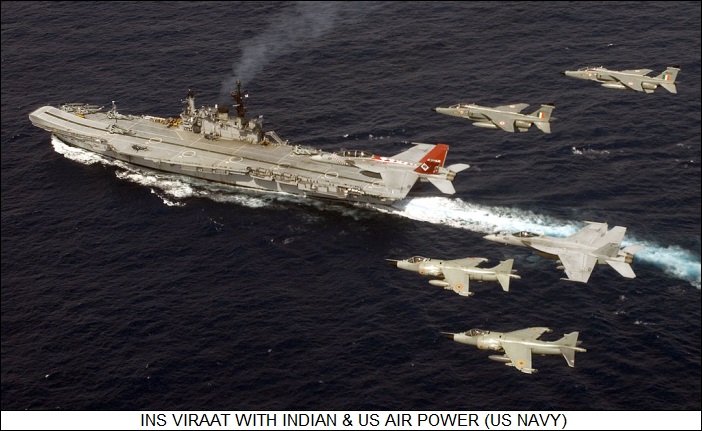
To be sure, China's naval buildup is more rapid than India can match, but India's sailors are more experienced -- they've been operating aircraft carriers since the 1960s, while China has yet to put a carrier into real service. India also has a "home field" advantage in the Indian Ocean, with naval forces backed up by shore-based aircraft and long-range antiship missiles. Another factor for China to consider is India's cultivation of naval relationships with Vietnam, South Korea, Japan and, most significantly, the USA. India now conducts more naval exercises with America than with any other country. [TO BE CONTINUED]
NEXT | COMMENT ON ARTICLE* AFRICA IN THE 21ST CENTURY (10): The paperwork issues underlying the emergence of the new nation of South Sudan were discussed here in 2011. An article from THE ECONOMIST ("A New Country Rises From The Ruins", 4 May 2013) took a closeup of the practical issues confronting South Sudan.
Welcome to the village of Liriya in South Sudan, with its rows of tin shacks, mud roads, and general air of poverty. A visitor who had seen it before independence would not notice much different -- but on closer inspection would see some improvements, such as an emerging public water system and educational facilities. There is still less than meets the eye, unfortunately; the solar-powered pumps for the water system have a backup generator for days of bad weather but there's little fuel available for the generator, and most parents can't afford to send their kids to school.
That scene represents South Sudan in a nutshell. The government's plans to bring public services to an impoverished population of about 12 million, three-quarters of them illiterate, aren't making rapid progress. The country is bigger than France but has almost no infrastructure, with less than a percent of the people with access to electricity. A foreign worker there commented: "This place makes Afghanistan look developed." Without foreign aid, the government would collapse.
Officials say that they simply can't do everything overnight, and that change is coming, however slowly. Infant mortality has dropped from 102 per thousand to 76, still appalling but an improvement. The country's first major paved road, from Juba, the capital, to Nimule, on the border with Uganda, was completed in 2012. However, South Sudan still tops the world's charts for maternal mortality, and 60% of the population is isolated when the rainy season comes -- accessible only by United Nations helicopters.
South Sudan has potential: a lot of oil, more cattle than people, enough farmland to feed most of sub-Saharan Africa, plus abundant minerals and timber. Unfortunately, the chicken-&-egg problem of development remains: exploitation of resources demands infrastructure, without exploitation there's no way to fund infrastructure.
Building a government effectively from scratch is enough trouble. A corps of 200,000 civil servants has been created, but about half are useless, former guerrillas given sinecures to keep the peace. Eventually, the dead wood in the civil administration will have to be phased out, but that's not likely to happen soon. The government also suffered when it shut down oil production in early 2012. The idea sounded mad, but the only oil pipeline out of South Sudan was through Sudan, and the Sudanese government was demanding excessive transit fees.
Cutting off oil exports was taking a big risk, and during 2012 South Sudan's precarious economy took a disastrous nosedive. However, South Sudan survived, largely because it didn't have far to fall, most of the people scratching by at a subsistence level in the first place. Surprisingly, private money even fueled a building boom in Juba during the time of hardship, with buildings sprouting up in the place of shanties, while population there doubled to about 1.2 million.
Finally, the government in the north blinked, coming to a more reasonable arrangement, with South Sudan resuming production in April 2013. South Sudan's leaders ended up looking tough and smart, teaching Omar al-Bashir, Sudan's president and a bully, that South Sudan wasn't going to be intimidated. In the wake of the agreement between the two countries, Omar al-Bashir visited Juba for the first time.
There are still problems between the two countries, with about six border regions in dispute. UN peacekeepers are trying to keep warfare from breaking out, but tensions are high. Both sides are waiting on a report from an African Union panel that will outline a solution, and both have said they will go to international arbitration to iron out their differences on the matter. Nobody wants war.
Unfortunately, South Sudan still has a lot of war going on within its own borders; during decades of fighting, feuds between communities went out of control, and the violence continues. UN peacekeepers are helping in that regard as well, and the government recently appointed a number of bishops to head a new commission to oversee reconciliation between warring tribes and factions.
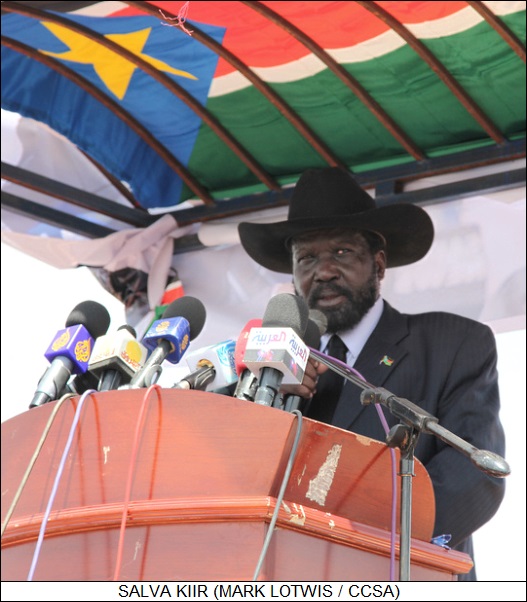
South Sudan's past history and present state of violence have also resulted in a government with authoritarian tendencies, noted for human rights abuses, summary executions, and intimidation of journalists. Tales of government corruption are common; police openly ask for bribes. South Sudan's President Salva Kiir expressed his dismay at the failings of his government in an open letter to his senior officials: "We fought for freedom, justice and equality. Once we got to power, we forgot what we fought for and began to enrich ourselves at the expense of our people." [TO BE CONTINUED]
START | PREV | NEXT | COMMENT ON ARTICLE* SCIENCE NOTES: It is obvious that the penguin evolved from flying ancestors -- even more obvious when penguins are observed swimming in a zoo tank, since they "fly" underwater using their stubby wings. However, as discussed in SCIENCEMAG.org, that leads to a puzzle: why did they lose the ability to fly? Wouldn't it seem an advantage to be able to both fly and swim?
Researchers from the University of Manitoba in Winnipeg, Canada, decided to examine the question by examining the thick-billed murre, Uria lomvia, which nests on cliffs in Alaska, Canada, and other northerly sites. It swims through the water with its wings to scoop up krill and plankton, but it also flies -- if not very well, beating its wings frantically and landing clumsily.

The research team studied murres living in northern Canada, the researchers living in a cabin surrounded by an electric fence to ward off predatory polar bears, and carrying shotguns loaded with rubber slugs to drive off bear attacks. They fitted the murres with sensors to track their movements above and below the water, and injected them with tracer molecules to track their energy use. The results showed that murres have to expend more energy to stay aloft than any other bird. When flying, murres burn energy at 31 times their resting rate, while the rate for other vertebrates in intense activity is only about 25.
On the other side of the coin, murres are less efficient swimmers than penguins. In other words, murres are stuck with doing two things poorly instead of one thing well. However, the compromise obviously works for the murres, the ability to fly -- however badly -- compensating in survival value for less efficient swimming.
* As reported by TIME.com, camels were imported into Australia from India, Arabia, and Afghanistan in the 19th century for transport in the Outback; the beasts found Fourex to their liking, and feral camels are now commonplace across Western Australia, South Australia and Queensland. They're quite a nuisance, one big problem is that they can drink a watering hole dry very quickly. They also are aggressive grazers, depleting food sources for native species such as kangaroos; and because of their size, they can do fair damage to infrastructure such as fences, water tanks, pumps and pipes.

Most are single-humped dromedaries, with a few double-humped bactrians in the mix. Aussie farmers and ranchers have taken to shooting the beasts; another approach is to herd them into pens with helicopters, to be sold and shipped off elsewhere as meat on the hoof for slaughter. Australian animal-rights activists have been lobbying against the practice. For now, the problem seems out of control.
* In other news of out-of-control invasive species, south Florida is now struggling to deal with giant African land snails. They're huge, about the size of an adult person's hand, and have ravenous appetites, eating just about anything that's green. They even eat through drywall, obtaining calcium to build their shells, while leaving trails of slime behind them everywhere they go.
The snails have already overrun some Caribbean islands such as Barbados, where they puncture car tires and generate razor-sharp shrapnel when run over by lawn mowers. Florida state authorities have been catching them at a rate of about a thousand a week in Miami-Dade County, but that doesn't promise to get rid of the pests, with nobody having any good idea of what to do about them.
COMMENT ON ARTICLE* NANOWIRE SOLAR CELLS IN PROGRESS: The technology of solar cells has been advancing steadily over the past decades, but solar cells still remain uncompetitive on a level playing field against nonrenewable energy sources. As reported by an article from SCIENCEMAG.org ("Performance Of Nanowire Solar Cells On The Rise" by Robert F. Service, 18 January 2013), a relatively new solar cell technology, based on "nanowires", seems to be advancing rapidly at the present time.
Traditional solar cells are made of layers of monocrystalline silicon; they've achieved good efficiencies, but they still remain expensive. It is also possible to manufacture solar cells using glassy or "amorphous" silicon; they're not so efficient, but they're cheap. About a decade ago researchers starting tinkering with the idea of building solar cells as grids of tiny vertical pillars, "nanowires". The attraction of the idea was that the nanowires greatly reduced the amount of refined semiconductor material, promising a solar cell that was both efficient and cheap.
Unfortunately, nobody could get nanowire solar cells to efficiently produce electricity -- until now. In late 2012 and early 2013, a number of research teams from around the world reported that they had built nanowire solar cells with high efficiencies, with separate teams from Sweden, Germany, and China claiming their nanowire devices converted 13.8% of the sunlight falling onto them into electricity. That's still below the 15% to 22% of monocrystalline silicon solar cells, but advocates of nanowire solar cells feel that there's room for great improvement in the technology.
In a solar cell, sunlight dislodges free electrons from the cell material that are collected into a current. One challenge in solar cell design is to make sure that free electrons stay free to be collected; a big problem is that they can recombine with vacancies left in the material by other free electrons, known as "holes". The difficulty with nanowire arrays is that, while the nanowires reduce the amount of semiconductor needed, they also provide a lot of surface area, with defects in the surface promoting recombination.
The Swedish team, under the direction of Magnus Borgstroem of Lund University, built its nanowires with indium phosphide because it inhibits recombination, and also used a scheme known as "metal oxide chemical vapor deposition (MOCVD)" to create wires with a very low defect rate. South Korean and American teams have created slightly less efficient nanowire solar arrays using cheaper metallic silicon, and other fabrication techniques. All the researchers believe that they will obtain even better efficiencies using improved fabrication techniques.
However, they're chasing a moving target, since conventional solar cell technology continues to improve, particularly with regards to cost. That means nanowire solar cells will need to have a clear advantage over traditional technology in order to stay in the race. In the broad view it's a good problem to have, since it means that solar, if still a niche energy production technology at the present time, is going to occupy a bigger niche in the future.
COMMENT ON ARTICLE* BUSTED: As discussed in an article from THE ECONOMIST ("Falling Crime: Where Have All The Burglars Gone?", 20 July 2013), twenty years ago Estonia, in the wake of the collapse of the Soviet empire, was plagued with crime. Veteran policemen in Tallinn, the capital city, remember what it was like then: rowdy punks drunk and violent on vodka, vandalism all over, citizens in a hurry to get home before nightfall, police raids made in force lest they take on more than they could handle.
How things have changed. Since 1995, the country's murder rate has dropped by 70%, and robbery and car theft have fallen almost as far. Despite the recession, which sent unemployment in Estonia well into the double digits, crime has kept on falling. This phenomenon isn't local to Estonia, either; crime, which had risen around the world from the 1950s, is now on a global downward trend.
Police records, which underestimate some types of crime, as well as surveys of victims, which are less biased but harder to come by, both show crime against persons and against property falling over the past ten years in most rich countries. In the USA, the fall began around 1991; in Britain, it began around 1995, though the murder rate didn't follow for another decade. Some crimes seem to be actually fading out: in 1997, some 400,000 cars were reported stolen in England and Wales, but only 86,000 were stolen in 2012.
It's the big cities that have been leading the way. Since 1990, the number of violent crimes has fallen by 32% since 1990 across America as a whole, but the fall has been at twice that rate in the biggest cities. In New York City, the area around Times Square on 42nd Street used to be seedy and dangerous, but now it's a glitzy family tourist trap. In London's housing blocks, children play in concrete corridors once used by heroin addicts to shoot up. In Tallinn, nobody is scared to walk home in the dark any more.
Why the fall in crime? Demographics may be one factor. The postwar "baby boom" meant a surge in the number of men in the range of 16 to 24 years old, the group most likely to commit crimes, in the 1960s, but now Western populations are aging, in some cases rapidly. However, that's obviously not the only reason. London's population of young men has been rising in recent years, even as crime continues to decline there. Some categories of crime have fallen by 90% in New York City and Los Angeles, a fall far too steep to be explained by demographics.
Sociologists have come up with a number of other explanations, ranging from legalization of abortion to the introduction of unleaded gas -- but few find such arguments very convincing, and in a few cases they come across as downright offensive. There has been a push towards locking more people up in places such as the USA, Britain, and Australia, but countries such as Canada, the Netherlands, and Estonia have cut prison populations, and have seen their crime rates continue to drop. New York state, which has been locking fewer people up, has seen strong drops in crime.
Locking people up, in a sense, doesn't stop crime, because people have to commit a crime to get locked up. True, while they're locked up they can't commit any more crimes against the public, but it would better if people didn't commit crimes in the first place. That's actually what appears to be happening. The drop in crime seems to be due to people not becoming criminals in the first place: between 2007 and 2012, the number of people convicted of an offense for the first time in Britain fell by 44%.
As for dealing with crimes that are committed, on inspection it seems more significant for people to get caught through better policing than severely punished. Committing a crime and having nothing to show for it but trouble is an education for a criminal in itself, the magnitude of the trouble being a secondary if not necessarily unimportant issue. In New York and Los Angeles, where crime has fallen at an extraordinary rate, Bill Bratton, a former police chief of both cities, is often credited for the turnaround. Bratton pushed higher standards: Today's LAPD is a far cry from the corrupt, racist, and scandal-ridden force of the 1990s, and its tactics are much more effective.
The biggest improvements have been through two practices: police trying to stay in touch with the people whose neighborhoods are being patrolled, and intensive targeting of crime "hotspots". In the 1990s, Bratton embraced data-driven "CompStat" policing, flooding the most hazardous districts with officers. The biggest subsequent crime drops were localized: for example, in the area around Canal Street in Lower Manhattan, the murder rate fell from 29 per 100,000 residents in 1990 to around 1.5 by 2009. The same approach is working around the world. Along with better policing, private security firms have been a growth industry around the world, with "rentacops" outnumbering the real police in some places.
Cultural changes have driven the fall in crime rates as well. Recreational drug use is not as widely fashionable as it was, and drunkenness less socially acceptable. Domestic violence has been becoming unfashionable as well, being much more heavily stigmatized. Repopulation of inner cities, with tenements taken over by the prosperous and "gentrified", also plays a part. To be sure, once a neighborhood goes upscale the poor are simply driven out to a new poor neighborhood, but the investment in the city does help reverse its decay and, generally, improve the well-being of the whole. A rising tide helps float all boats.
And then there's technology. There is justifiable caution about the "technological fix", but it seems to be a big factor in deterring crime. DNA testing and surveillance cameras means that a criminal is more likely to get caught and convicted; there are so many camera phones around that anything big and troublesome that happens is likely to end up on YouTube. Home security systems are more effective and more common, shops have invested heavily in security, while cars are much more difficult to hot-wire. Fewer businesses keep much cash around, and they're likely to keep less as electronic money becomes more popular. Those that do keep much cash around have become hardened targets. The falling cost of technology has also made gadgets less worth stealing; the rapid evolution of consumer tech means it depreciates so fast that an item a few years old may be effectively unsalable.
Of course, technology has also given opportunities for crime. As discussed here last spring, smartphone theft has been a growth industry, as have online scams. Technology can help here, for example by making smartphones easier to trace and easier to lock down once they're lost. There's also the murky world of sexual offenses, where crimes often go unreported, so nobody is sure whether they're rising or falling. However, overall the trendline is down -- and by all evidence, it appears likely to stay on that trajectory.
COMMENT ON ARTICLE* BIOFUEL BATTLE (4): Even if cellulosic ethanol production meets expectations over the short term, it's faced with another problem: competition from corn ethanol. That may seem surprising since corn isn't regarded as anywhere near an optimum biofuel feedstock -- but at present, filling stations aren't required by law to sell E15 or E85, with E15 pumps being unusual and E85 pumps rare. That means ethanol is only a small component of the US fuel market right now; corn ethanol has the market locked down, and cellulosic ethanol has a challenge getting in.
Advocates know this is a problem, but believe it will fix itself. With cellulosic ethanol coming into the market, ethanol costs will come down, and so there will be more push towards E15. Produce it, so the thinking goes, and it will sell. Unfortunately, there's another problem, in that blends with higher proportions of ethanol require flex-fuel vehicles. Ethanol producers certainly think it would be nice if E85 were widely available, but it won't be so until flex-fuel cars are common. The problem, of course, is that even though flex-fuel cars don't cost a large premium, there isn't any public demand for them given the non-availability of E85, and so auto-makers don't want to produce them. Biofuel advocates would like Congress to take further action to prime the E85 market.
Taking a less heavy-handed approach, NREL is working to set up a meeting of representatives from oil companies, refiners, carmakers, and filling stations in hopes of hammering out a consensus plan for the way forward. Biofuel boosters are optimistic about the long-range future of cellulosic ethanol and other renewable fuels, but it turns out that to get from here to there means tackling an interlocked set of "chicken & egg" problems. That ends up meaning the application of awkward government bureaucracy, but doing nothing seems the worst option, and it's hard to think of better ones.
* As a footnote to the topic of cellulosic biofuels, an article from SCIENCEMAG.org ("Could Wood Feed the World?" by Charles Q. Choi on 15 April 2013), a team under bioprocess engineer Y.H. Percival Zhang, of the Virginia Polytechnic Institute and State University in Blacksburg, has come up with a scheme for converting cellulose into starch for human consumption.
Cellulose is composed of hundreds to thousands of molecules of the sugar glucose, and starch compounds are made of glucose as well, although the sugar is bonded together in different ways. The research teams took genes from certain species of bacteria, soil fungi, and potatoes, and then genetically modified the Escherichia coli bacterium -- the human colon bacterium, a common lab tool -- to produce the enzymes for the conversion. One set of these enzymes breaks cellulose down into smaller molecules, while the other set builds these components into starch.
So far, the process converts up to nearly a third of the cellulose into amylose starch. The rest of the cellulose is turned into glucose, which can be fermented into biofuel. The process works, but it's dreadfully expensive at present, though Zhang believes it shouldn't be too difficult to scale it up to an industrial process. Given the looming food crunch as global population heads for a peak around 2050, Zhang believes that cellulose conversion may be important for making sure the world stays fed.
* As another footnote to this series, a survey of biofuels from THE ECONOMIST mentioned studies that suggested acquiring adequate feedstocks for cellulosic biofuels would be problematic. True, agriculture does produce a great deal of plant waste, but not all of it actually goes to waste, for example being used in soil conditioning. Another problem is that plant waste is widely dispersed, and it would be troublesome to collect and transport it for processing.
I'm not so sure those are killer objections, one consideration being that there's no reason to assume cellulosic biofuel should carry the whole burden of fuel production: if it's cost-effective, it will be a benefit if it simply handles a significant component of it, as part of a spectrum of solutions instead of the complete solution itself. As far as the dispersal of wastes go, that less suggests impossibility than a proliferation of mini-plants, each producing biofuel for a local area. For example, a mini-plant might be associated with a municipal waste dump, or an agricultural products plant. The economics would certainly have to be examined carefully -- below a certain scale, a mini-plant is likely to be an economic absurdity -- but the idea does deserve investigation. [END OF SERIES]
START | PREV | COMMENT ON ARTICLE* AFRICA IN THE 21ST CENTURY (9): Regarding the comments earlier in this series on the Islamic insurgency in the Sahara region, an article from THE ECONOMIST ("Secure The Sahara, If You Can", 6 July 2013) discussed the situation in Mali.
Things were not looking well there early in 2013. Mali has long been poor, but at least it had a democratic government and was generally peaceful -- until a separatist faction of the Tuareg desert nomads in the north of the country got their hands on weapons looted from Libyan arms depots and rose up against the government. They were joined by jihadis hoping to establish an Islamic state -- and then a military coup toppled the Malian government, paralyzing the army.

French President Francois Hollande ignored warnings of a quagmire and sent 4,000 troops in to deal with the insurgency, with Britain and the US providing backup. Professional French troops quickly suppressed the uprising; the Tuaregs, who had come to loathe the jihadis, said they were interested in reconciliation, as long as some agreement could be devised on autonomy. The French allowed some Tuareg forces to remain intact for a time -- to then surrender to troops from Chad, a component of African forces working along with the French. In late June, the Tuareg signed a peace deal.
The jihadis were pushed back to the mountainous border with Algeria, French troops pursuing them energetically and beating them bloody, if failing to wipe them out. As far as the political crisis in Bamako, the capital of Mali went, it's sorted itself out to a degree. On 26 June Captain Amadou Sanogo, who led the coup against the government, apologized to the people of Mali for his actions, while interim president Dioncounda Traore has been trying to get the country's factions to work together.
New elections are to be held to establish a fully legitimate government; the logistics of performing the election have proven shaky, however, so there's talk of delay until a credible vote can be taken. Nobody sees much point in setting up a shaky government that will fall over in its own turn. The United Nations is assisting with a peacekeeping mission including 12,000 troops -- including West Africans already there working with the French; some French troops; and even 500 troops of the Chinese People's Liberation Army. The force is to be fully in place by the end of 2013. Rich countries have promised $4.2 billion USD in aid to Mali.
* The French intervention against the jihadis seems to have sent them packing; Malians had little enthusiasm for jihad, so presuming things stabilize in Mali, the jihadis are not likely to stage a comeback there. The problem is that the Sahel, the southern fringe of the Sahara, is jihadi country; they know the land, its size and ruggedness gives them plenty of room to hide, and they have opportunities in the poor and unstable states of the region. The jihadis are not hurting for money, running smuggling networks across the desert, and finding kidnapping a profitable business -- they are believed to have accumulated $60 million USD from kidnapping in the last decade.
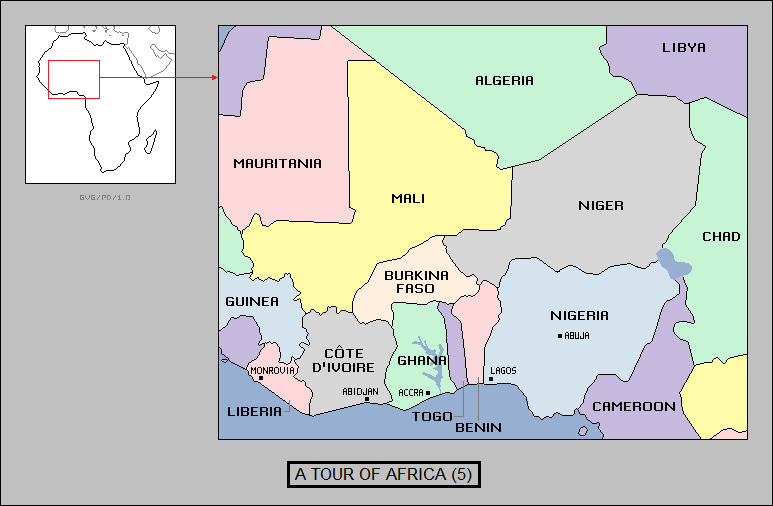
Having been run out of Mali, the jihadis are raising hell in next-door Niger, partly because Niger backed the intervention in Mali. Niger is weak, on the bottom of development indexes, and the jihadis hit hard, one Malian official commenting: "We were braced for an attack, but not on this scale." The French and Americans have offered military assistance, which has been gratefully accepted, US drones now taking pot-shots at jihadis.
Even in Ghana, the region's most successful state, jihad is making leaders nervous. They're not worried about a jihad there, Ghana being relatively prosperous and peaceful -- but Ghanian President John Mahama worries about knock-on effects of the turmoil: "If we allow that foothold to consolidate, then it could affect the stability of our entire region. We need to act collectively as a sub-region and a continent and indeed globally to be able to ensure peace and stability."
Indeed. American drones and firepower can do little to change the basic equations in Africa; better governance and development can do a lot more. Very specifically, the states of the region need to collaborate and tighten up their border security, instead of allowing criminals and extremists -- the line between the two is indistinct -- to come and go as they please, to cause nothing but trouble wherever they like. [TO BE CONTINUED]
START | PREV | NEXT | COMMENT ON ARTICLE* GIMMICKS & GADGETS: As reported by BLOOMBERG BUSINESSWEEK, a startup named Canary out of New York City has developed a wi-fi-enabled home security system named, of course, the "Canary". It's in the form of a cylinder about the size of a large beer can, housing an imager, a microphone, and climate sensors. All a user has to do is set up the Canary in a location where it can see the open area of a room, and then it observes normal activity in the room. If events occur that seem out of the ordinary, or there's an intrusion during a time period when everyone is supposed to be out of the house, it sends an alert and video to the user's smartphone. It can also send alerts to a list of emergency contacts.

Up to four Canaries can be set up in a home. Optional features include an HD imager with night vision, an accelerometer that allows a Canary to detect when it's moved, and a siren that a user can activate via smartphone. The Canary is now in testing, with expected deliveries in the spring of 2014. Price is given as $199 USD for a baseline Canary module.
* WIRED.com reported on a US Department of Transportation study, conducted with a large fleet of vehicles fitted for wireless communications, rolling around Ann Arbor, Michigan. The wireless links worked in the 5.9 gigahertz band and had a range of about 300 meters (1,000 feet); using the links, each car sent out a "Basic Safety Message", including its GPS location, about ten times a second. A car with a receiver could then determine the speed and location of each car near to it, taking action when a collision with another wireless-enabled car is possible. The wireless system could also, in potential, pick up warnings from construction sites and emergency vehicles.
* In other auto news from WIRED.com, South Korean tire maker Hankook has now developed an experimental tire, the "i-Flex", which never needs inflating or having its pressure checked. Derived from concepts originally developed by global tire giant Bridgestone, the i-Flex is based on a lattice of geometric cells lining the inside of the wheel; the energy from bumps is distributed and dissipated across the structure. Not only does the i-Flex never go flat, it is also lighter and more efficient. However, Hankook is not saying when the i-Flex will be on the market.

* In yet other automotive-tech news from WIRED.com, Mercedes is now working with Google to integrate the Google Glass eyewear display with car navigation systems. The idea is that, working with a smartphone and the car digital systems, Google glass would give the proper cues to guide the driver to a designated destination. It's just in the proof-of-concept phase right now, but Mercedes has plans to formally integrate Google glass in future auto systems.
BLOOMBERG.com ran an article on the potential of Google Glass for a wide range of practical applications, beginning with a surgeon wearing Google Glass while rebuilding a knee, relaying video imagery to medical students and a consulting physician in another location. Indeed, Google expects most initial buyers to be businesses and government organizations that will see the relatively high intro price as a bargain for the value.
Technicians could use it to read manuals; it could be used for workplace collaboration, and in particular for real-time interaction between public safety workers. If the functionality is good and there are no big drawbacks, once Google Glass drops in price it is likely to become a universal technology. That does pose a number of problems, one being that employers will be able to track employee Google Glass use, and there's not much the employees could do about it.
COMMENT ON ARTICLE* GAIA MAPS THE SKY: Once astronomers understood that the stars were distant suns and not just little lights in the sky, they tried to find out just how far away they were. The most reliable way of doing so turned out to be "stellar parallax", the shift in the sky position of the brighter (and so hopefully nearer) stars relative to the fainter (and so presumably more distant) matrix of stars around them. However, such shifts were necessarily tiny, and so the parallax method could only be used for the nearest stars.
The 1989 launch of the European Space Agency's (ESA) "High Precision Parallax Collecting Satellite (HIPPARCOS)" did much to extend the reach of parallax measurement, the spacecraft mapping the positions of over 100,000 stars to a high degree of precision and several millions of stars to a lower degree of position, until the end of the mission in 1993. HIPPARCOS was a grand success even though it was placed into the wrong orbit, mission scientists adapting to circumstances to put the satellite to work.
Now, as reported by an article from BBC.com ("Gaia: The 'Impossible Space Mission' Ready To Fly" by Jonathan Amos, 21 August 2013), the ESA is preparing to fly a successor to HIPPARCOS, named "Gaia" -- originally for "Global Astrometric Interferometer for Astrophysics", though it didn't end up being an interferometer -- that will greatly exceed its predecessor in all respects. Gaia is to be launched by a Russian Soyuz-Fregat booster from the ESA Kourou Space Center in French Guiana in late 2013, with the spacecraft taking up station in a loop around the Earth-Sun L2 position, about 1.5 million kilometers (930,000 miles) from Earth in the direction of the Sun. There it will be balanced between the gravitational attraction of the two bodies, and will have a generally unobstructed view of the sky that it would not have in Earth orbit.

Once at the L2 point, the two tonne (2.2 ton) Gaia will deploy a sunscreen around its base to block out sunlight, and start scanning the sky. The spacecraft features a double telescope system, the main mirrors being in a rectangular format and having dimensions of 1.45 x 0.5 meters (135 x 20 inches) each. The mirrors are made of silicon carbide, for low mass and thermal stability, and are arranged at an angle of 106.5 degrees to each other. Light from the mirrors is fed through an elaborate optical system to a suite of three instruments:
The instruments feed a total of 106 charge-coupled device (CCD) imaging sensors, which provide a total resolution of over a billion pixels. Gaia will observe a staggering billion stars, logging a concise catalog entry for each one of them. Its observations will have an accuracy of about seven micro-arcseconds -- 100 times the accuracy of HIPPARCOS, along the lines of seeing from Earth the button on the suit of an astronaut standing on the Moon. To obtain this precision, the spacecraft was designed with absolute stability in mind. It has no moving parts; the antenna that links it to Earth is electronically steered. It uses a gentle cold nitrogen gas thruster system for position-keeping.
Along with its star-mapping mission, Gaia will log anything that flashes across its field of view. It will list vast numbers of asteroids, comets, new planets, failed stars, variable stars, exploded stars, and visible galaxies. In its five-year mission, it will observe 40 million objects a day and obtain a petabyte -- 100,000 gigabytes -- of data, which will require extensive supercomputer time to render into the final catalog, expected to be available no earlier than 2020. There will be no immediate need for a successor mission because it's going to take a long time just to digest Gaia's data.
Astronomer Gerry Gilmore of Cambridge University in the UK is particularly excited about what Gaia will reveal about galactic evolution, saying: "We will see the remnants, the debris streams, of the first shards that became what is today the Milky Way. We can run the process right back to the first things that ever happened. We will see the entire history of the Milky Way unfolding before our eyes."
BACK_TO_TOP* ANOTHER MONTH: What would become the International Red Cross was founded in 1863 by a Swiss businessman named Henry Dunant, who had become convinced after witnessing the gruesome battle of Solferino in Italy in 1859 that something had to be done to ensure that battle casualties received proper medical care. That led to the consideration of treatment of wounded enemy troops, and from there to a concern for war crimes in general.
Now the Red Cross is expanding its scope of concerns from the real to the virtual world, working with developers of "first person shooter" games to incorporate considerations of the rules of war. Battle games are wild shoot-em-ups, and generally don't make much distinction on who gets shot up. The result is a tendency of gamers to blast away at anything that moves.
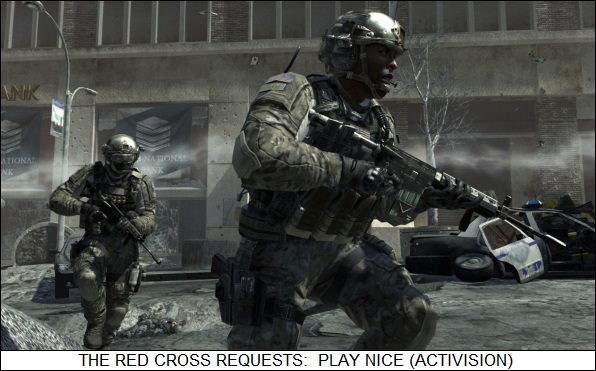
Making a fuss over battle games may seem a bit silly, games not actually doing anyone harm in themselves. However, Red Cross officials don't see it as too much to ask that games nick players for points when they shoot civilians and are indiscriminate in their use of firepower. The officials point out that modern battle games are very vivid and realistic, and gamers who play them tend to be young men who may become soldiers, or actually are soldiers. As the military puts it, train as you fight, fight as you train, and battle games amount to a form of training. It couldn't hurt to encourage restraint, though the idea admittedly does lead to the vision of MODERN WARFARE XIII: WAR CRIMES TRIALS.
* We had a long hot dry summer in northeast Colorado, made more tolerable, if not perfectly so, by my acquisition of an air conditioner -- incidentally, I thought my power bills would skyrocket, but I hardly noticed a difference. Anyway, in the second week of September rain began to fall. It seemed unusually persistent, but then this isn't a rainy place, rain is somewhat out of the ordinary to begin with, and I didn't pay it too much mind. On Thursday, 12 September, I read reports of flooding in Boulder to the south. I failed to follow up that thought to seriously consider what might be happening in Loveland as well.
The next morning, appropriately Friday the 13th, I decided to drive to the gym, only to find that I wasn't going anywhere -- Loveland having been cut in half north to south by the flooding of the Big Thompson River running through it west to east. I drove around a bit to see if I could get around the roadblocks -- to finally realize that I needed to go home and STAY home to get out of the way of the emergency services. That day and the next was characterized by considerable activity of helicopters buzzing around to assist the stricken.
Things are still being sorted out. Although some people were killed elsewhere, while many were flooded out in Loveland, I don't think anyone got hurt in here; one of the women at the Loveland library drowned, but she lived in the mountain canyon upriver, a deathtrap when the rains come down too heavily. Not having a skyview of what happened, I don't know exactly how much harm was caused to the town, but from what samples I could see -- road damage, park cleanup, and the like -- the repair bill is likely to run into millions, maybe tens of millions of dollars. [A 2017 article said the cost of repairing Loveland's parks, golf courses, and open lands ran to $8.6 million USD.]

Incidentally, in the photo above, the river is behind the treeline in the background of the park, suggesting how out of control things were. No, I didn't see what that scene was like at the flood crest, the area was blocked off and I was staying home anyway. It dawned on me on consideration that the city not only has parks along the river for the scenic value, but at least secondarily to provide a buffer space against floods.
According to news reports, there's a particular worry with the oil stations in the region. There are few, if any, big oil fields in Colorado -- just pumping stations with tanks and pipeline gear dotted here and there over the landscape -- but the flood still resulted in a fair number of damaged oil tanks and other facilities, meaning an expensive oil spill cleanup effort. Still, it could have been worse, there was a flash flood through Loveland in 1976 still remembered by old-timers, the calamity having killed 44 people.
I was fortunate, living nowhere near a watercourse; I didn't even have a power outage, which was surprising since I get power outages about twice a year or so for no evident reason. The supermarket hadn't run out of anything when I went shopping -- which happens when we have a big snowstorm or the like -- the only personal effect being the city government telling the citizens to leave their lawn sprinkler systems off until the water supply system was back up to full operational standard. I turned it off and didn't turn it back on before blowing it out for the winter. I thought it a bit strange to be in the middle of a disaster area and not really notice. Still, on the wider view, what a nightmare; I dug into my reserves to make a donation to the local Red Cross, that being the least I could do to help.
* I got to thinking in mid-September that I might like to run a monthly skeptic's column, and started to write up a first installment. I wrote a few paragraphs, suddenly thought: No, no, no, no, no. -- and deleted them. Chasing after the lunatic fringe is unconstructive slumming if I want to do useful things with my time. As I grow older, I become more detached, inclined to wonder if a fuss really amounts to anything as far as I'm concerned -- and often realizing it doesn't.
COMMENT ON ARTICLE